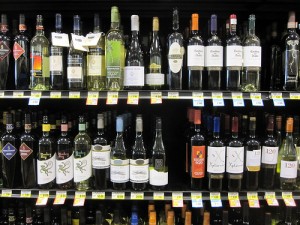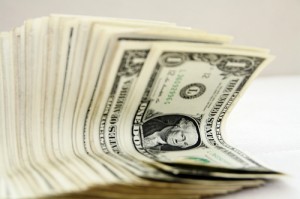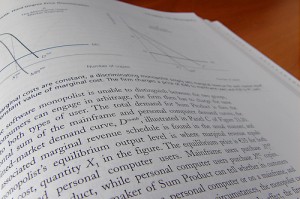Have you ever gone to a store to purchase wine one day and it’s a certain price, then go to buy the same wine in a different store later and you notice it is a few dollars more expensive? Before you go thinking that you’re just crazy, you should know that the retail wine marketin the United States is known for its large price dispersions. For example, retail wine price data has shown that a 2007 Yellow Tail Merlot in a wine shop in upstate New York is $4.99, while the same exact wine is $9.99 in Jersey City, New Jersey. Going to the high end of the spectrum, the same data set found that a 2005 Chateau Latour ranges from $695 in a shop in Petaluma, California to $2,000 in a shop outside Chicago, Illinois.
Why is it that wine prices are so variable from shop to shop in the United States?
There could be a variety of factors why price dispersion of wine is so large in the US, including differences in production, differences in consumer demand, or different market regulations set forth by the federal government or the state government. In regards to regulation, it is primarily up to the individual states how wine is sold within their borders; however, the federal government does require a federal wine tax be paid on all wines. There is quite a large variation in how each state regulates their wine sales, with some states selling wine only at state-owned wholesale shops, some allowing the sale of wine only at particular types of private businesses or at certain times of the day/week, and some even imparting restrictions on how and where to ship wines to others.
How can price dispersion persist?
If the search for information on a product is ultimately costly for the consumer, price dispersions are able to persist in otherwise stable markets. In other words, if it takes too much time, effort, and sometimes money to find correct pricing information for a product, the consumer will just forgo this search and assume the sticker price is correct and will willingly pay that amount. With the advent of the internet, the ability for consumers to search for pricing information has improved dramatically, allowing consumers to more easily find the information they are looking for in much less time than they would have spent without this technological resource. Even though this is theoretically how it would work, some studies have found that consumers will still give up before they are fully informed on a product, even with the internet at their fingertips.
In some cases, price dispersion may be in jeopardy if the consumer learns through experience. Since inexpensive wines are purchased more frequently than expensive wines, one can imagine that the same cheap wines are being purchased over and over again by the same individuals. Therefore, over time, these consumers would learn more about the pricing information of a particular wine by experience or by word of mouth by another consumer, thus forcing a much narrower range of price in the market. If the consumers know the wine is
only $4.99 at one store, they will be very unlikely to ever purchase the same wine at a different shop for $9.99. The prices then over time “work themselves out” and form a tighter, less variable price dispersion in the market.
The paper presented today, while brief and more a starting point for further research, aimed to examine whether state effects or county effects explain these price dispersions of wine in the United States, and if the degree of dispersion is the same for both inexpensive and expensive wines.
Methods
The researchers used a large online wine pricing data base encompassing the years 2006 through 2008 in order to collect price information of wines.
To determine how local market characteristics affect wine prices, a complicated mathematically model was employed, which took into account the following factors: wine type, vintage, county, state, year of price posting, number of retail wine establishments in a given county, the county population during the year 2000, race, and age.
Results
- 186 wine brands were analyzed.
- A total of 106,000 prices were found for these wines.
- For nearly all wines (except for one), there were over 200 difference prices found throughout the United States.
- For many wines (exact number not specified), there were over 1,000 prices found throughout the US.
- Most of the wines analyzed were from the US, and 2/3 of them were red varietals or blends.
- The overall price dispersion of the wines analyzed was 23.4%.
- Price dispersion was higher for reds than for whites.
- Price dispersion was higher for French wines than for American wines or all other imports.
- Price dispersion was higher for expensive wines than inexpensive wines.
- Based on the mathematical model, results showed that prices vary with local market conditions.
- Even so, local market conditions only explained between 7% (red wines) and 13% (white wines) of the price dispersions.
- For both red and white wines, the relationship between price dispersion and average price was significantly stronger for vintage wines than nonvintage wines.
Authors Conclusions
The authors of this short study concluded by saying that yes, a wide price dispersion for wine exists in the United States, with the average price dispersion falling around 23.4%. Based on the mathematical model results, the authors
attributed this dispersion partially to different local market conditions, though differences in this dispersion may also be due in part to price levels, and after controlling for variations due to consumer, market, and state regulations.
Since it was found that more expensive wines carry with them a larger price dispersion than inexpensive wines, the authors conclude that this could be indicative of a “learn by experience” or “word of mouth” phenomenon. Since more people purchase the inexpensive wines, and since the same individual is likely purchasing the same wines more frequently, they are more informed and aware of what the appropriate price should be. On the other end of the spectrum, the authors suggest it is also possible that those seeking to purchase expensive wines incur a larger opportunity cost of time, and do not have the time to search out the best price for their wine of inquiry.
Final thoughts
Overall, I thought this study was interesting; however, it left me wanting to know a lot more. I feel as though this study just gets at the tip of the iceberg that is price dispersion of wine in the United States. To me, it reads more like a pilot/preliminary study, which is fantastic, but I’m now left with the sense of “oh man, that’s it?”.
I would like to see this study taken a bit further and would like to see some other results teased out. The authors included many different factors in their mathematical model equation, however, they don’t really go into details about how many of them influence price dispersion.
What about you all? I would love to hear your thoughts on this study and what sorts of things you would have liked to see done differently (if anything). What sorts of questions do you think need to be asked next? Please feel free to leave your comments and participate in the discussion!
Source: Jaeger, D.A., and Storchmann, K. 2011. Wine retail price dispersion in the United States: Searching for expensive wines? American Economic Review: Papers & Proceedings 101(3):136-141.




4 comments for “Wine Retail Price Dispersions: A Closer Look into Wine Economics in the United States”